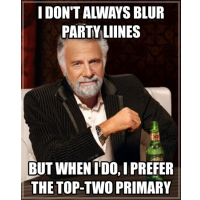“Top-Two” Primary Fails to Unleash the Pragmatic, Centrist California Voter

Hopes, and fears, that California's new “top-two” primary system would change the state's electoral process for better, or worse, appear to be unrealized, so far.
The California Journal of Politics and Policy devoted its first issue of the new year to the state’s “enormous democratic experiment” in 2010, when voters passed Proposition 14, and the general consensus among researchers was that not much changed. Holding a single open primary in which the top two vote-getters, regardless of their party affiliation, are the only ones to advance to the general election did not produce less polarization, an increase in turnout or different outcomes.
The journal, produced by the Institute of Governmental Studies at the University of California, Berkeley, published seven articles and eight commentaries exploring various aspects of whether top-two produced more moderate, pragmatic lawmakers. “The bulk of the research reaches common conclusions from different approaches.”
Top-two did not make a difference.
Jonathan Nagler of New York University found “that surprisingly few voters crossed party lines, and relatively few who did so did so for strategic reasons. If such low levels of cross-over continue, the impact of the top-two primary on candidate ideology will likely be small.”
Thad Kousser of UC San Diego found that top-two shaped the field by influencing who entered or stayed out, how they shaped their campaigns and the ballot designations they sought. But it did not “discernibly alter the outcomes of the 2014 primaries.”
Five researchers at UC Berkeley studied why ideological moderates did not prosper in the June 2012 top-two and decided “a primary reason is that voters are largely ignorant about the ideological orientation of candidates.” You can’t vote for the moderate in a race if you don’t who they are. They found, “Voters held fuzzy beliefs about candidate ideology that came nowhere close to the knowledge necessary for identifying the moderate candidates reformers presumed would be favored.”
So what do underinformed voters do when, faced with a general election runoff between two members of the same party, they can’t rely on ideological party cues to guide them? They Google it, according to Betsy Sinclair and Michael Wray of Washington University in St. Louis. The researchers gathered Google Trends data on 72 Assembly members and 37 in the state Senate, and compared relative changes between politicians with co-partisan challengers and those opposed by the opposite party. They found candidates facing someone from the same party were Googled 13% to 15% more often.
“We suggest the possibility that voters bear the burden of participatory democracy in this context by seeking out additional political information online,” they said.
The hunt for the illusive—some would say mythological—independent centrist voter continues. Many of the journal articles made it clear that they were dealing with a small sample of voters just becoming familiar with the demands of a new system and suggested they might behave differently in the future.
Kevin Drum at Mother Jones pointed out that the introduction of top-two primaries coincided with California’s decision to move all votes on initiatives to general elections. The absence of that proven voter draw probably changed the composition of the electorate and made it difficult to compare results with past years.
Although not much has changed so far, a top-two primary in 2014 did highlight the sort of electoral spectacle that voters might find entertaining in a Reality TV kind of way, although its utility in the cause of a better electoral process is remote. Researcher Kausser noted the surprising finish of unknown Republican David Evans in the State Controller’s race, who nearly finished second to Republican Ashley Swearengin when Democrats John Perez and Betty Yee split their party’s vote.
Democrats, who have an overwhelming electoral advantage in statewide races, nearly didn’t have a candidate in the general election. Kausser entitled his analysis: “Controller’s Race: Disaster Narrowly Averted.”
–Ken Broder
To Learn More:
Jungle Primaries in California: It Looks Like a Big Fat "Meh" (by Kevin Drum, Mother Jones)
New Research: Four Lessons from California’s Top-Two Primary (by David Siders, Sacramento Bee)
Top-Two Primary System Hasn't Worked as Proponents Promised (by Mark Z. Barabak, Los Angeles Times)
Third Parties Lose Court Appeal of “Top-Two” and Their Place on California Ballots (by Ken Broder, AllGov California)
The California Top-Two Primary (California Journal of Politics and Policy)
- Top Stories
- Controversies
- Where is the Money Going?
- California and the Nation
- Appointments and Resignations
- Unusual News
- Latest News
- California Forbids U.S. Immigration Agents from Pretending to be Police
- California Lawmakers Urged to Strip “Self-Dealing” Tax Board of Its Duties
- Big Oil’s Grip on California
- Santa Cruz Police See Homeland Security Betrayal in Use of Gang Roundup as Cover for Immigration Raid
- Oil Companies Face Deadline to Stop Polluting California Groundwater





